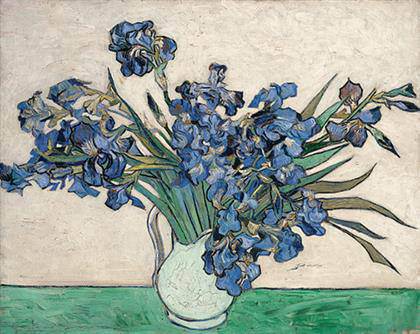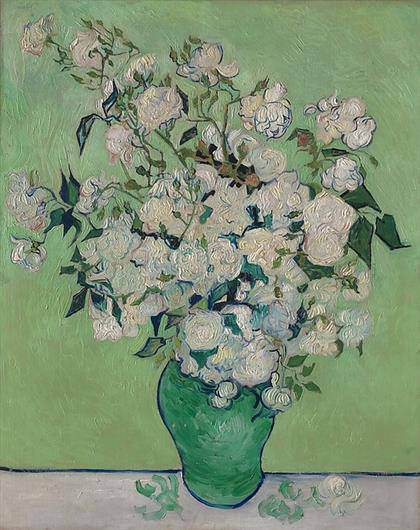
Vincent van Gogh, Irises, 1890.
Oil on canvas.
The Metropolitan Museum of Art, Gift of Adele R. Levy, 1958

Vincent van Gogh, Roses, 1890.
Oil on canvas.
Metropolitan Museum, The Walter H. and Leonore Annenberg Collection
Gift of Walter H. and Leonore Annenberg, 1993
Bequest of Walter H. Annenberg, 2002
Van Gogh: Irises and Roses – Metropolitan Museum The exuberant bouquets of spring flowers that punctuate Van Gogh’s work in Provence will be reunited in ‘Van Gogh: Irises and Roses’ at The Metropolitan Museum of Art, from May 12 to August 16, 2015.]]>
Source: Metropolitan Museum
The exhibition will bring together for the first time the quartet of flower paintings—two of irises, two of roses, in contrasting formats and color schemes—that Van Gogh made on the eve of his departure from the asylum at Saint-Rémy in which he sought to impart a “calm, unremitting ardor” to the “last stroke of the brush.” Conceived as a series or ensemble on a par with the Sunflowers decoration painted earlier in Arles, the group includes the Metropolitan Museum’s Irises and Roses and their counterparts: the upright Irises from the Van Gogh Museum, Amsterdam, and the horizontal Roses from the National Gallery of Art, Washington, D.C. The presentation is timed to accord with the blooming of the flowers that had captivated the artist’s attention, opening 125 years to the week that Van Gogh announced he was working on these “large bouquets” in letters to his brother dated May 11 and 13, 1890. It will offer a revealing look at the signature still lifes in a singular context, inviting reconsideration of his artistic aims and the impact of dispersal and color fading on his intended results.
Van Gogh worked with steady enthusiasm on the suite of irises and roses during his last week at the asylum at Saint-Rémy, where he had taken refuge since the previous May (for a condition diagnosed by his doctors as a form of epilepsy). With his release from institutional life in sight, he marked the end of his stay with flowers from the overgrown garden he had depicted upon his arrival, bringing his work in Saint-Rémy full circle. At the same time, he extended his repertoire of still life painting (which had suffered neglect in the interim) with an admirable sequel to the glorious Sunflowers series of Arles.
They were painted while he was packing his belongings for his move to Auvers, in the wake of an incapacitating breakdown that had robbed him of early spring—a pocket of time he likened to the calm after the storm. Completed just three days before he boarded the northbound train, the bouquets took shape in swift succession. He was determined to make up for lost time, to prove he had not lost his touch, and to make the “last strokes” count. Van Gogh’s facility of execution matched the rigor of his conception. He relied on canvases corresponding in size and composition, each anchored by a slightly off-center vase and unified by a common horizon line. Within the group he paired the works by subject, format, and style, engaging them in a rich dialogue of contrasts, the whole governed by the assertive play of contrasting complementaries—yellows/violets, pinks/greens—used in different combinations for different expressive effects. These ranged, as Van Gogh noted of the violet irises, from the “effect of terribly disparate complementaries” of the bouquet against a yellow background, to the “soft and harmonious” effect of the bouquet against pink.
Related content
Van Gogh Museum reopens with anniversary exhibition ‘Van Gogh at work’ (exhibition, 2013)
Follow us on:


